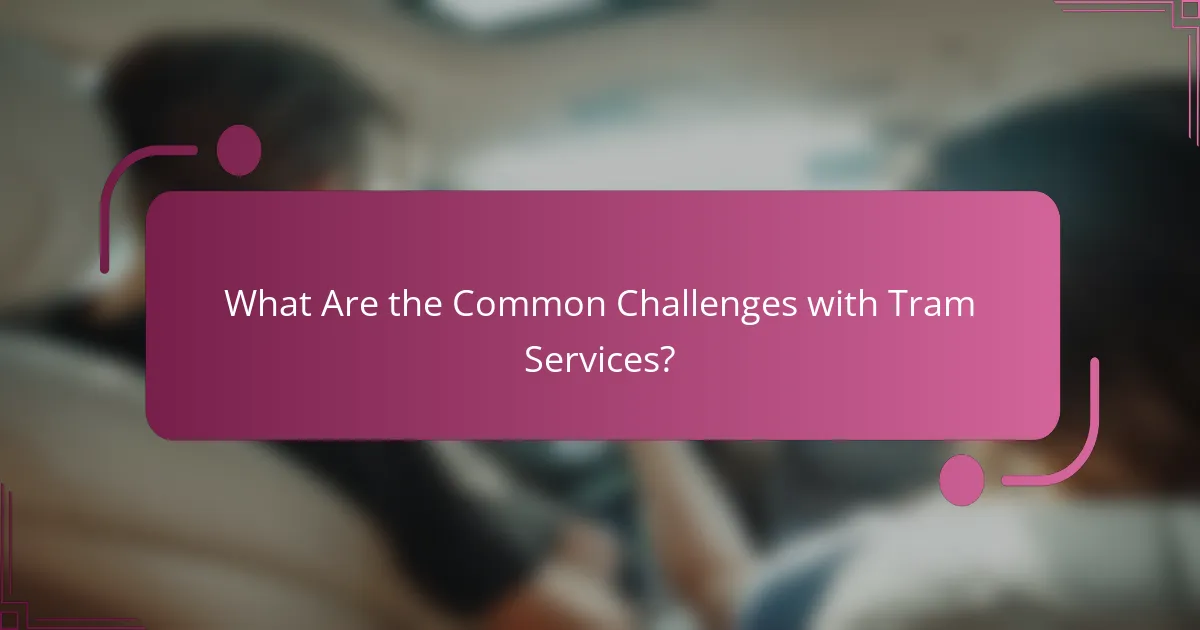Tram services provide an affordable and eco-friendly way to navigate urban environments, making them a popular choice for commuters. To make the most of your tram travel, it’s essential to plan your journey, stay updated on schedules, and understand ticketing options. By following these easy travel tips, you can enjoy a seamless and efficient experience on trams.

How to Use Tram Services Effectively?
Using tram services effectively involves planning your journey, staying informed about schedules, and understanding ticketing procedures. By following a few practical tips, you can ensure a smooth and efficient travel experience.
Plan your route in advance
Before you embark on your tram journey, take some time to plan your route. Identify the tram lines that will take you to your destination and note any transfers you may need to make. This preparation helps you avoid confusion and delays.
Utilize online maps or tram service websites to visualize your route. Many cities provide interactive maps that highlight tram stops and connections, making it easier to navigate the system.
Check tram schedules online
Always check tram schedules online before you travel. Most tram services offer real-time updates on their websites or mobile apps, allowing you to see when the next tram is arriving. This can save you time and help you avoid long waits at the station.
Be aware that tram frequencies can vary throughout the day, especially during peak hours. Knowing the schedule can help you plan your departure time more effectively.
Purchase tickets before boarding
To avoid delays, purchase your tram tickets before boarding. Many tram systems allow you to buy tickets at kiosks, vending machines, or through mobile apps. Having your ticket ready ensures a smoother boarding process.
Check the ticketing options available in your city, as some may offer discounts for round trips or day passes, which can be more economical for frequent travelers.
Utilize real-time tracking apps
Real-time tracking apps can significantly enhance your tram travel experience. These applications provide live updates on tram locations, estimated arrival times, and service alerts. By using these tools, you can adjust your plans based on current conditions.
Many cities have dedicated apps for their public transport systems, so download the one specific to your area for the best results. Some apps even allow you to set reminders for when to leave for your tram.
Know the tram etiquette
Understanding tram etiquette is essential for a pleasant journey. Always give priority seating to elderly passengers, pregnant women, and those with disabilities. Keeping noise levels down and refraining from eating strong-smelling food can also contribute to a more enjoyable environment for everyone.
Be mindful of personal space and avoid blocking the aisles. If you’re traveling during busy hours, try to stand clear of the doors to allow for easier boarding and alighting.

What Are the Key Benefits of Tram Services?
Tram services offer several advantages, including affordability, environmental sustainability, and the ability to alleviate urban traffic congestion. These benefits make trams an appealing choice for daily commuters and city dwellers alike.
Cost-effective travel option
Trams provide a budget-friendly mode of transportation, often costing less than other forms of public transit like buses or taxis. Many cities offer discounted fares for students, seniors, and frequent riders, making trams an economical choice for daily travel.
For example, a single tram ticket may range from 1 to 3 EUR, while monthly passes can be available for around 30 to 50 EUR, depending on the city. This pricing structure encourages regular use and can lead to significant savings over time.
Environmentally friendly transportation
Tram systems are typically powered by electricity, which can be generated from renewable sources, reducing their carbon footprint compared to gasoline or diesel vehicles. This shift towards electric-powered transit contributes to cleaner air and lower greenhouse gas emissions.
Moreover, many cities are investing in modern tram networks that utilize energy-efficient technologies, further enhancing their environmental benefits. Choosing trams over cars can help individuals contribute to a more sustainable urban environment.
Reduced traffic congestion
Trams can significantly decrease the number of vehicles on the road, helping to alleviate traffic congestion in busy urban areas. By providing a reliable and efficient alternative to personal cars, trams encourage more people to opt for public transport.
In cities with well-developed tram networks, studies have shown that public transport can reduce traffic by up to 30%, leading to shorter travel times and less frustration for all road users. This shift not only benefits commuters but also enhances the overall quality of urban life.

What Are the Common Challenges with Tram Services?
Tram services often face several challenges that can affect the reliability and convenience of travel. Common issues include delays due to maintenance, limited coverage in certain areas, and accessibility problems for disabled passengers.
Delays due to maintenance
Maintenance-related delays are a frequent challenge for tram services, often resulting in service interruptions. These delays can occur during scheduled maintenance or unexpected repairs, leading to longer wait times for passengers.
To minimize inconvenience, it’s advisable to check the tram service’s website or app for real-time updates on maintenance schedules. Many cities provide alerts about service changes, allowing travelers to plan accordingly.
Limited coverage in some areas
Tram networks may not cover all neighborhoods, leaving some areas without direct access to tram services. This limited coverage can make it difficult for residents in those regions to rely on trams for daily commutes.
When planning a trip, consider using alternative transportation options, such as buses or rideshares, to reach your destination if tram service is unavailable. Familiarizing yourself with the tram map and identifying nearby stops can also help in navigating the system effectively.
Accessibility issues for disabled passengers
Accessibility can be a significant concern for disabled passengers using tram services. Not all tram stations are equipped with ramps, elevators, or other necessary facilities, which can hinder access for individuals with mobility challenges.
Before traveling, check the tram service’s accessibility features online. Many services provide information on which stations are fully accessible and offer assistance options for passengers who need help boarding or disembarking.

How to Choose the Right Tram Route?
Choosing the right tram route involves understanding your destination, major stops, and connections. By assessing these factors, you can select a route that minimizes travel time while ensuring a comfortable journey.
Identify major stops and connections
Start by reviewing the tram map to identify key stops along your route. Major stops often include central hubs, transfer points, and popular destinations, which can significantly affect your travel experience.
Check for connections to other tram lines or public transport options, such as buses or trains. This can help you plan a seamless journey, allowing for easy transfers if needed.
Consider travel time and frequency
Evaluate the expected travel time for each tram route. Some routes may take longer due to more stops or detours, while express services can reduce travel times significantly.
Frequency is another critical factor. Trams that run every few minutes are preferable, especially during peak hours, as they reduce waiting time and improve overall convenience.
Evaluate safety and comfort
Safety is paramount when choosing a tram route. Research the reputation of the tram service and check for any recent safety incidents or complaints from passengers.
Comfort can vary between tram lines. Look for services that offer modern trams with adequate seating and amenities, such as air conditioning or Wi-Fi, to enhance your travel experience.

What Are the Local Tram Services Available?
Local tram services typically include city tram networks, regional tram services, and private operators. These options provide convenient transportation for residents and visitors, connecting key areas and attractions within urban and suburban settings.
City Tram Network
The city tram network serves as the backbone of urban transport, offering frequent and reliable service throughout metropolitan areas. Trams usually run every few minutes during peak hours, making them a practical choice for daily commuting.
Most city tram systems operate on fixed routes with designated stops. It’s essential to check the local schedule and map to plan your journey effectively. Many cities also provide real-time tracking through mobile apps.
Regional Tram Services
Regional tram services extend beyond city limits, linking suburban areas to urban centers. These services typically operate less frequently than city trams, with intervals ranging from 15 to 30 minutes, depending on the time of day.
When using regional trams, be aware of ticketing zones, as fares may vary based on distance traveled. Some regions offer discounted passes for regular users, which can save money over time.
Private Tram Operators
Private tram operators may offer specialized services, such as tourist trams or luxury experiences. These trams often feature unique routes that highlight local attractions and may include amenities like guided tours.
While private tram services can be more expensive than public options, they provide a distinct way to explore a city. Always check for schedules and ticket prices in advance to ensure a smooth experience.

How to Stay Informed About Tram Service Updates?
To stay informed about tram service updates, utilize official transit websites, mobile apps, and social media channels. These platforms provide real-time information on schedules, delays, and service changes, ensuring you have the latest details for your journey.
Check Official Transit Websites
Official transit websites are reliable sources for tram service updates. They typically feature live schedules, route maps, and announcements about service interruptions. Bookmark your local tram service’s website for quick access.
Look for sections dedicated to service alerts or news, which often highlight planned maintenance or unexpected disruptions. Many sites also offer email or SMS notifications for subscribers, ensuring you receive updates directly.
Use Mobile Apps for Real-Time Information
Mobile apps from transit authorities provide convenient access to real-time tram information. These apps usually include features like live tracking, estimated arrival times, and notifications for service changes. Download your local tram service app to enhance your travel experience.
Some apps allow users to set alerts for specific routes or stops, making it easier to stay informed about any changes that may affect your journey. Check user reviews to find the most reliable app for your area.
Follow Social Media Channels
Social media channels of tram services are effective for receiving quick updates. Platforms like Twitter and Facebook often post real-time alerts about delays, cancellations, and service improvements. Follow these accounts to stay in the loop.
Engagement with these channels can also provide insights into community feedback and upcoming changes. Look for posts that include hashtags related to service updates for easier tracking.
